Want your raised bed garden to thrive? Start by choosing a sunny spot, just like a sunbather at the beach! Prepare your soil by testing it and mixing in compost or worm castings—it’s like giving your plants a nutrient-packed smoothie! Don’t forget to water wisely—drip systems keep things cozy for roots! Keep pesky weeds at bay with thick mulch or organic sprays. Intrigued? There’s so much more to explore in your gardening adventure!
Choosing the Right Location
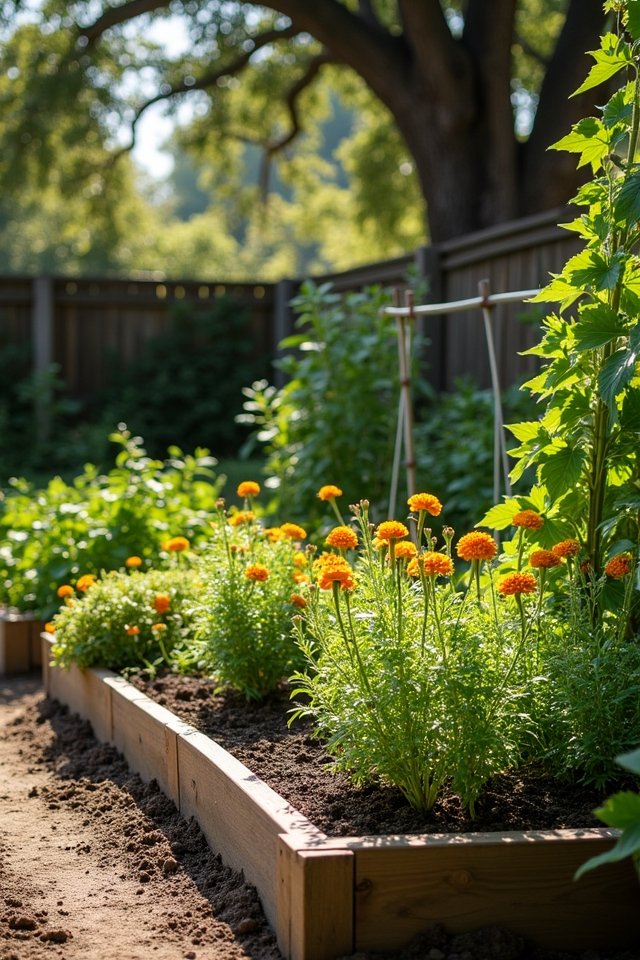
Have you ever wondered why the right spot for your raised bed garden feels like winning the jackpot? Well, it’s all about sunlight exposure and proximity accessibility! Imagine your plants soaking up the sun’s warm rays, as you stroll just a few steps from your kitchen. Picking a sunny spot is essential; think of it as giving your veggies their daily dose of happiness!
Also, consider how easily you can access your garden. A short walk means fresh ingredients at your fingertips, ready to spice up dinner. Plus, avoid shaded areas like those pesky tree canopies—your plants deserve better! So, scout your yard, visualize the perfect spot, and get ready for a thriving garden that feels like your personal paradise!
Soil Preparation and Nutrient Management
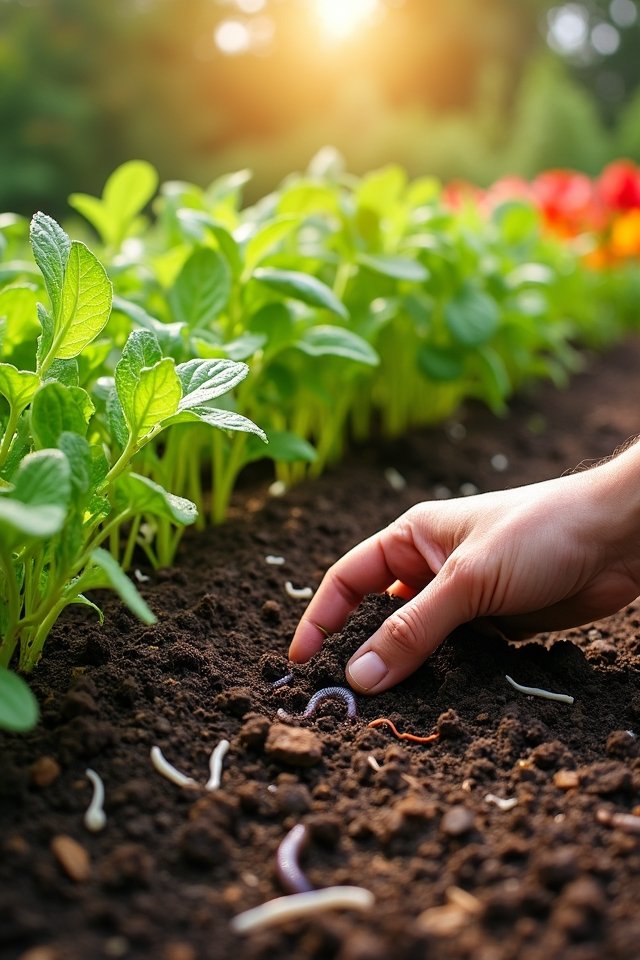
Soil is the heart of your raised bed garden, and giving it some love is essential for a bountiful harvest! To get started, consider these innovative steps for stellar soil preparation and nutrient management:
- Test Your Soil: Nutrient testing first helps you understand what your soil needs.
- Add Soil Amendments: Mix in compost, worm castings, or peat moss to boost crucial nutrients.
- Mulch Frequently: A layer of mulch retains moisture, protects against weeds, and breaks down to enrich your soil over time.
Watering Techniques for Raised Beds
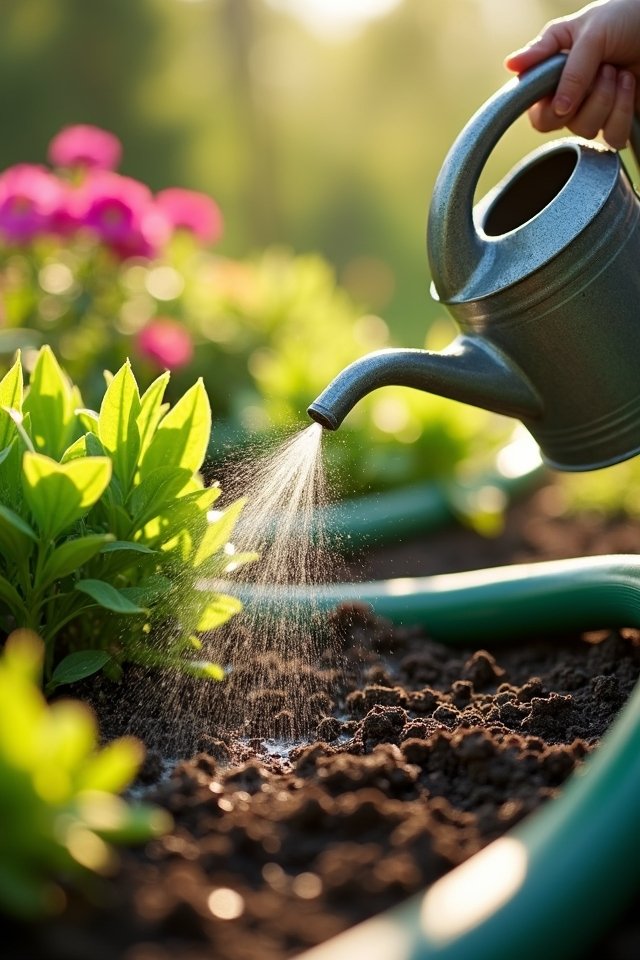
Once you’ve nailed down your soil game, it’s time to give your plants the hydration they crave! Watering isn’t just pouring; it’s an art! Adopt drip irrigation to harness a steady hydration rhythm, like a gentle rain falling every day. It delivers water directly to your plant roots, guaranteeing their thirst is quenched without wastage. Plus, it promotes moisture retention in the soil—your plants will thank you for that!
Consider adding mulch, too; it’s like a cozy blanket for your soil. But remember, a quick check verifies your water game is on point. Have your plants perked up? Or are they wilting like a forgotten salad? Adjust as needed—your green babies will flourish under your caring watch! 🌱
Weed Control Strategies

Weeds can be the uninvited guests at your gardening party, crashing in and stealing the spotlight from your vibrant veggies! To keep those pesky invaders at bay, adopt some innovative weed control strategies. Start with preventive measures that shield your lush plants, allowing them to thrive.
- Lay down a thick layer of mulch to block sunlight from weed seeds.
- Use biodegradable fabric barriers that naturally break down as your garden flourishes.
- Consider organic options, like vinegar sprays or boiling water, to zap weeds without harsh chemicals.
Have you ever noticed how a tidy garden inspires growth? With these smart tactics, you’ll create a thriving haven for your plants, keeping weeds where they belong—far away! Your veggies will thank you!
Pest Management Approaches
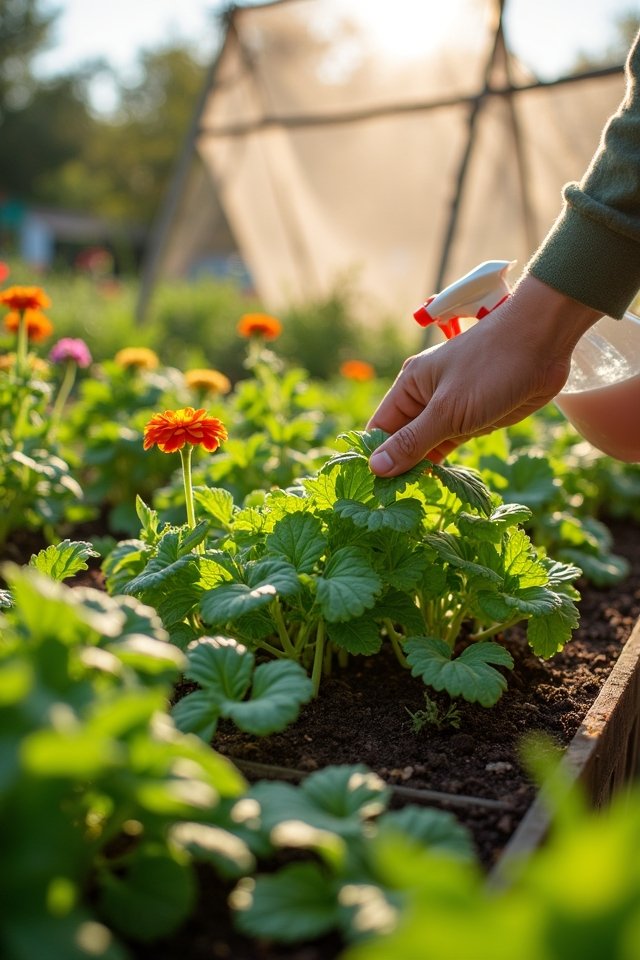
While you might think your garden is a peaceful paradise, pests can turn it into a chaotic battleground! Don’t worry, though—innovative pest management is your secret weapon. Try biological control, where nature’s own predators, like ladybugs, munch on those pesky aphids. It’s like hiring a tiny army to protect your blossoms!
Also, consider companion planting; it’s like matchmaking for plants! Plant marigolds alongside tomatoes to deter nematodes, or mix basil with peppers to keep harmful insects at bay. Imagine strolling through your vibrant, thriving garden, knowing you’ve outsmarted pests naturally. With these strategies, you’ll cultivate not just plants, but peace of mind, too. Get ready to transform your garden into a haven, free from pest mayhem!
Seasonal Planting and Crop Rotation
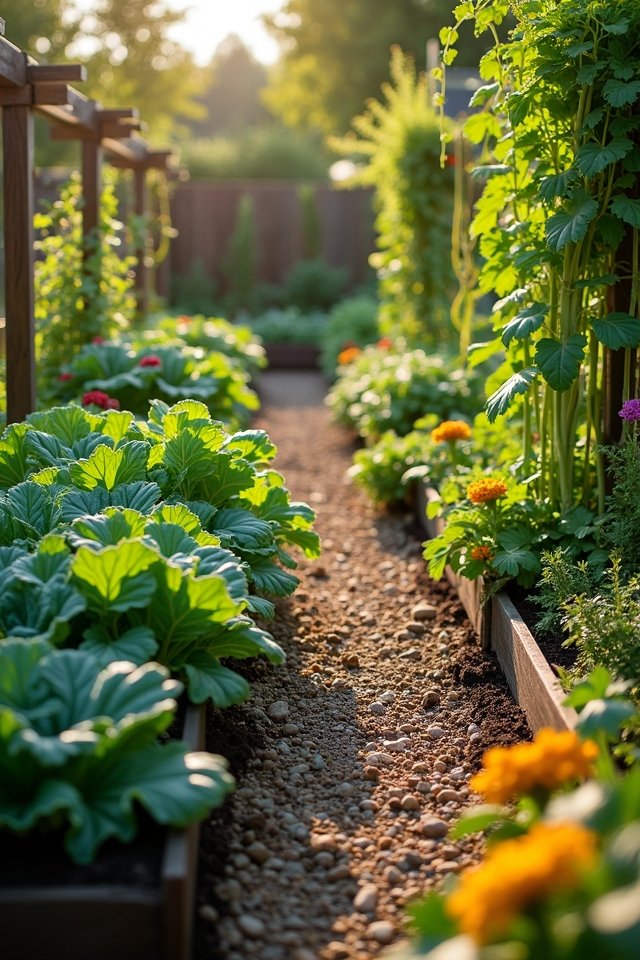
As you immerse yourself in the world of gardening, understanding seasonal planting and crop rotation can feel like a gardener’s secret superpower! When you mix up your crops, you create a rhythm in your garden that can lead to a bountiful harvest. Using planting calendars makes it easier than ever to track when to sow and when to reap. Consider these three innovative strategies:
- Welcome crop diversity by interplanting beans with corn.
- Rotate your peppers before planting tomatoes in the same spot.
- Plan your garden by incorporating fast-growing greens between slower crops.
This method not only keeps pests at bay, but it also enriches your soil! So, are you ready to master the art of seasonal planting? Your garden will thank you!
Mulching Benefits and Best Practices

Mulching isn’t just a chore; it’s like giving your garden a cozy blanket! When you spread mulch on your raised bed, you’re not only beautifying the space but also providing protection. Different mulch types—like wood chips, straw, or even grass clippings—bring unique benefits. For instance, shredded leaves retain moisture well, while straw prevents pesky weeds. Now, let’s talk application techniques! Aim for a 2-3 inch layer of mulch, keeping it away from plant stems to avoid rot. Feeling fancy? Try layering organic and inorganic mulches for an innovative touch! Your plants will thank you, thriving in their warm, snug environment. So, roll up your sleeves, and make mulching an exciting part of your gardening routine! Your garden deserves it!
Pruning and Deadheading Plants
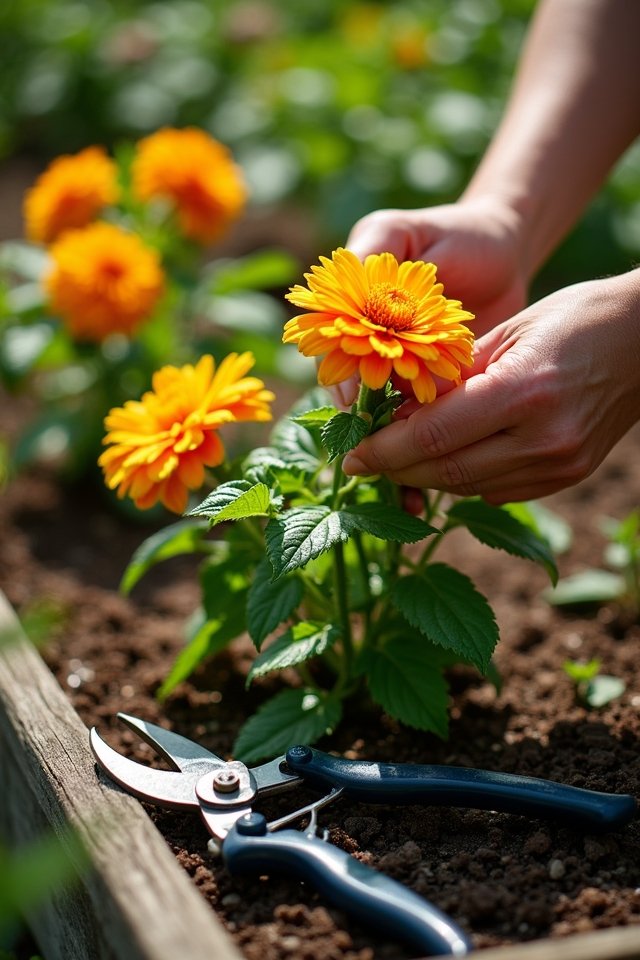
Get ready to give your plants a little TLC! Pruning and deadheading are your keys to vibrant gardens. By using effective pruning techniques, you stimulate new growth and shape your plants beautifully. Don’t forget the power of deadheading—removing those spent blooms encourages more flowering and keeps your plants looking fresh.
Here are some quick tips to maximize your efforts:
- Trim away dead or wilting leaves to promote health.
- Cut back overgrown stems to boost air circulation.
- Remove spent flowers to prevent seed formation, expanding blooming time.
With these simple practices, you’ll enjoy lush plants and a colorful garden! So, roll up those sleeves—your greenery will thank you with a burst of joyful growth!
Winter Care for Raised Beds
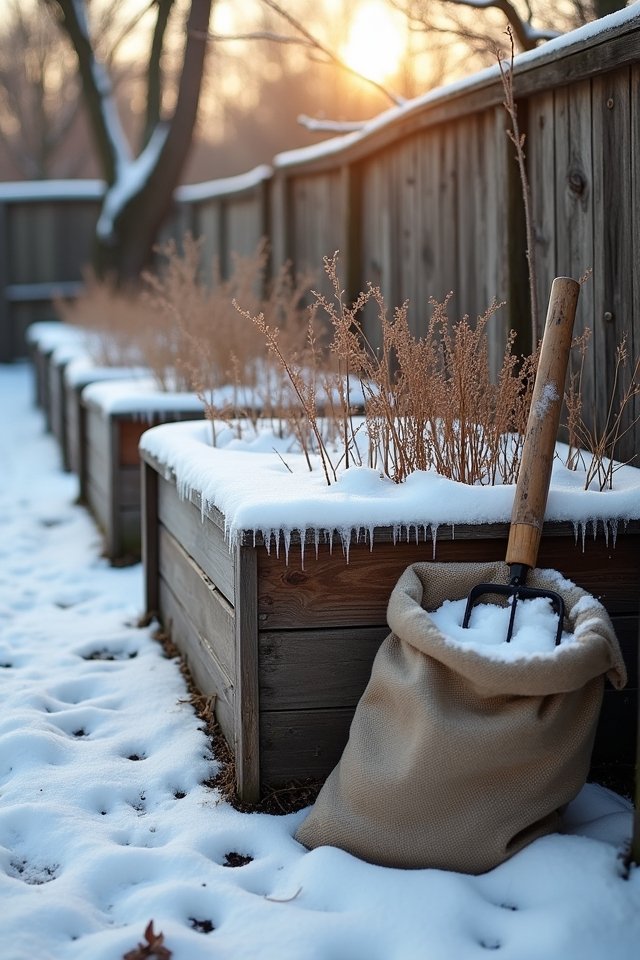
Winter’s knocking on the door, but don’t let that snowball your gardening spirit! Think of your raised beds as cozy little igloos for your plants. Start with winter insulation—layering straw or shredded leaves can keep the cold at bay. It’s like wrapping your garden in a warm blanket! For added frost protection, consider covering your beds with row covers or hoop tunnels. These innovations trap warmth and protect delicate roots from icy fingers. If you’ve got a few hardier veggies, welcome them! Kale and spinach can thrive even in frost. So, bundle up your beds and let winter work its magic. You’ll be surprised how alive your garden can feel, even in the cold months! Ready to get started?
Frequently Asked Questions
Can I Use Treated Lumber for Raised Bed Construction?
You might be tempted to use treated lumber for your raised beds, but beware! Treated lumber risks can leach harmful chemicals into your soil, jeopardizing your plants and health. Instead, why not explore alternative materials like cedar or redwood? They’re durable and naturally resistant to pests! Imagine your garden brimming with healthy veggies, thriving in safe, organic soil. Isn’t that a lovely thought? Let’s keep your garden beautiful and safe!
How Deep Should My Raised Bed Be for Optimal Growth?
When you’re diving into dreams of delicious veggies, consider your raised bed depth! Generally, aim for at least a foot deep for ideal soil and root growth. This depth encourages strong, sassy plants with healthy roots that dig down and explore! If you’re thinking about carrots or potatoes, bump it up to 18 inches. Just imagine those vibrant colors popping up, enthusiastic to greet you! Isn’t gardening a glorious adventure?
What Plants Are Best for Attracting Beneficial Insects?
Want to attract beneficial insects? You’ll love planting pollinator-friendly flowers like lavender and coneflowers! They lure those tiny helpers right to your garden, creating thriving insect habitats. Imagine vibrant blooms buzzing with life—it’s like nature’s party in your yard! Incorporate some sweet alyssum and marigolds too; their scents will enchant both pollinators and your senses! So, go ahead, make your garden an insect-friendly paradise, filled with nature’s little superheroes!
How Do I Prevent Soil Erosion in Raised Beds?
To prevent soil erosion in your raised beds, you’ll want to employ some nifty soil stabilization techniques! Try using mulch to create a protective layer that holds moisture, while reducing runoff. Consider adding drainage solutions like gravel at the base for cozy water flow. Some gardeners swear by planting deep-rooted flowers—think of them as nature’s anchors! You don’t want your precious soil washing away, do you? Get ready to cozy up with a thriving garden!
Can I Grow Vegetables in Raised Beds Year-Round?
Did you know that gardeners who grow vegetables year-round can yield up to 10 times more produce? Yes, you can absolutely grow seasonal crops in raised beds, even during winter! With a bit of creativity, like using cloches or cold frames, you’ll keep your greens cozy. Imagine munching on fresh kale while others are stuck with bland grocery store veggies! So, layer those blankets and get ready for a delightful winter gardening adventure!


